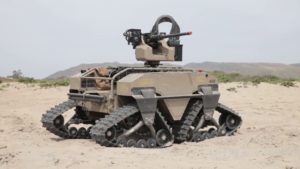The Army Is Looking for a Few Good Robots
By Debbie Gregory.
Robotics manufacturers are scrambling for more than a half billion dollars in Pentagon contracts for compact battlefield robots that will defuse bombs and scout ahead for soldiers on the battlefield. The Army’s immediate plans envision a new fleet of 5,000 ground robots of varying sizes and levels of autonomy.
The fight to win the contract shines a light on the need to stay competitive in the merging of technology and national defense, as international adversaries could come to dominate battlefield robotics.
During a Senate hearing last May, Army Chief of Staff Mark Milley warned that China and Russia “are investing heavily and very quickly” in air, sea, and ground bots.
“My personal estimate is that robots will play a significant role in combat inside of a decade or a decade and a half,” Milley added.
The intention of the project is to someday help troops “look around the corner, over the next hillside and let the robot be in harm’s way and let the robot get shot,” said Paul Scharre, a military technology expert at the Center for a New American Security.
Concerns that popular commercial drones made by Chinese company DJI could be vulnerable to spying led the Army to ban their use by soldiers in 2017.
The biggest contract, worth $429 million, calls for mass producing robots that are light, easily maneuverable and can be “carried by infantry for long distances without taxing the soldier,” said Bryan McVeigh, project manager for force projection at the Army’s research and contracting center in Warren, Michigan.
A $100 million contract for a mid-sized reconnaissance and bomb-disabling robot was won in late 2017 by Endeavor, a spinoff of iRobot which makes Roomba vacuum cleaners.
Unlike the efforts by China and Russia to design artificially intelligent war-fighting arsenals, the U.S. Defense Department is cautious about developing battlefield machines that make their own decisions.
A report from the Congressional Research Service in November stated that despite the Pentagon’s “insistence” that a human must always be in the loop, the military could soon feel compelled to develop fully autonomous systems if rivals do the same.








